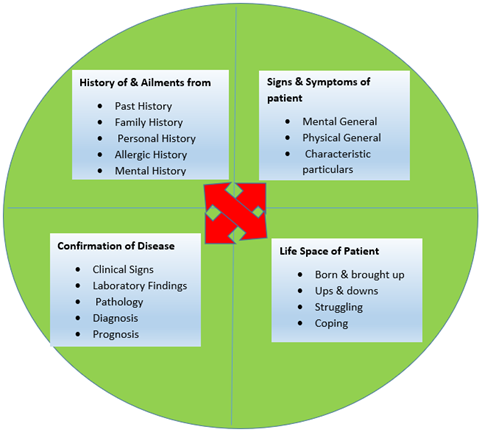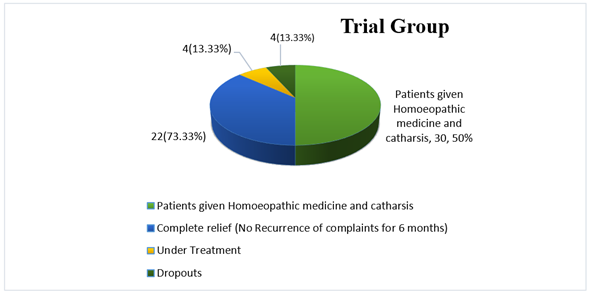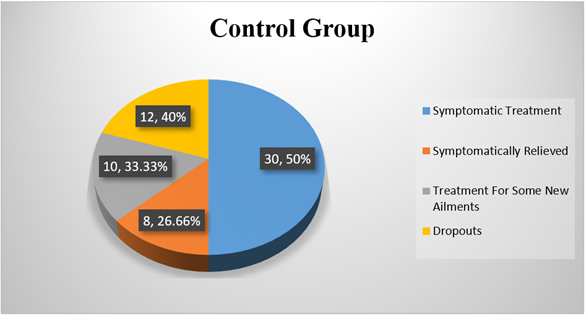
Catharsis and the Indian Mind: Understanding Introversion in Psychosomatic Healing
Tapas Kundu 1![]() ,
Rita Kundu 1
,
Rita Kundu 1![]() ,
Prapti Kalda 2
,
Prapti Kalda 2![]()
![]()
1 Guest
Professor, Motiwala (National) Homoeopathic Medical College, Nashik, India
2 PG
Scholar, Smt. K. B. Abad Homoeopathic Medical College, Nashik, India
|
|
ABSTRACT |
||
|
Catharsis, the act of releasing deep, pent-up emotions, plays a powerful role in both psychology and homoeopathy. It serves as a bridge between mind and body, helping hidden feelings rise to the surface so that they can be expressed, understood, and eventually dissolved. This emotional release restores inner balance and strengthens the body’s vital force, paving the way for true healing. This article sheds light on how emotional suppression and introversion shape the health of individuals in Indian society. Traditionally, Indian culture values emotional restraint and collective harmony. While this fosters social stability, it also encourages people to keep their emotions bottled up. Over time, this inward tendency can contribute to a range of psychosomatic disorders, illnesses that reflect the impact of the mind on the body, including digestive problems, skin conditions, anxiety, and hypertension. This research highlighted how catharsis can be a crucial step in recovery. By allowing people to express repressed feelings in a safe, conscious way, emotional energy is released and healing can begin. Homeopathy naturally supports this process, as it considers the emotional and mental state an integral part of treatment. Remedies suited to introverted constitutions help patients open up, facilitating both emotional release and physical improvement. Through
clinical insights, cultural understanding, and homoeopathic principles, this
article explains why catharsis is not just a concept but a practical tool for
healing psychosomatic diseases. It encourages practitioners to create spaces
where patients feel safe to express their inner worlds, because when emotions
find their voice, the body often finds its relief. |
|||
|
Received 07 September 2025 Accepted 08 October 2025 Published 12 November 2025 Corresponding Author Prapti
Kalda, praptikalda2016@gmail.com DOI 10.29121/granthaalayah.v13.i10.2025.6429 Funding: This research
received no specific grant from any funding agency in the public, commercial,
or not-for-profit sectors. Copyright: © 2025 The
Author(s). This work is licensed under a Creative Commons
Attribution 4.0 International License. With the
license CC-BY, authors retain the copyright, allowing anyone to download,
reuse, re-print, modify, distribute, and/or copy their contribution. The work
must be properly attributed to its author.
|
|||
|
|
|||
1. INTRODUCTION
1.1. The Silent Mind of Indian Society
India’s sociocultural framework has long emphasized emotional restraint, endurance, and conformity as core virtues. From early childhood, individuals are encouraged to respect authority, prioritize family obligations, and suppress personal grievances in order to maintain social harmony. Emotional expression, especially when it involves personal dissatisfaction or vulnerability, is often discouraged. Over generations, this collective attitude has shaped a society that values introversion, where emotions are contained rather than openly expressed.
This deeply rooted cultural orientation plays a significant role in shaping personality structure. This research offers valuable insight into this phenomenon. Using Kundu’s Introversion–Extroversion Personality Inventory to assess 80 patients, the study revealed that 78 were introverts and only 2 were extroverts. This overwhelming majority reflects how traditional Indian upbringing, with its focus on self-control, humility, and emotional suppression, directly influences personality development.
While emotional restraint contributes to social cohesion, it can also create internal psychological pressure. When emotions are consistently repressed, they often find alternative channels of expression through the body, leading to psychosomatic disorders. Conditions such as anxiety, digestive disturbances, skin diseases, and hypertension frequently have emotional undercurrents that remain unaddressed.
Recognizing this sociocultural backdrop is essential for understanding the emotional landscape of patients. By acknowledging how upbringing shapes emotional expression, practitioners can better address both the psychological and physical dimensions of illness, paving the way for more holistic healing.
2. The Psychosomatic Connection: When the Mind Speaks Through the Body
Homoeopathy, rooted in Dr Samuel Hahnemann’s Organon, views disease as a dynamic disturbance of the vital force. When emotions are suppressed, the vital force expresses disharmony through the body, manifesting as physical illness.
It was observed that in Indian patients, grief, anxiety, fear, guilt and suppressed anger etc. were the most common emotional origins of psychosomatic disease. Typical manifestations included:
· Migraine, asthma, or peptic ulcer (linked to anxiety or emotional repression)
· Arthritis and skin disorders (linked to suppressed anger or grief)
· Hypertension and obesity (linked to prolonged emotional stress)
Thus, mental silence does not equate to peace; rather, it often conceals an internal storm seeking expression through somatic channels.
3. Methodology
3.1. Case Extraction Tool
To ensure systematic and comprehensive history-taking, a four-quadrant case extraction tool was employed for all patients in this study. This tool facilitated the structured collection of data in the following domains –
1) History of Ailment: including past history, family history, personal history, allergic history, and mental history.
2) Signs and Symptoms: covering onset, duration, and progress of complaints, along with mental generals, physical generals, and characteristic particulars.
3) Life Space of the Patient: exploring their upbringing, life struggles, coping mechanisms, and significant life events.
4) Confirmation of Disease: through clinical signs, laboratory findings, pathology, and diagnostic investigations such as ECG, X-Ray, EEG, and histopathology.
This structured approach provided a clear case extract, enabling accurate disease diagnosis, miasmatic diagnosis (fundamental and dominant), and the elicitation of mental generals, physical generals, and characteristic particulars, all of which are essential for constitutional homoeopathic prescribing.

The study involved 80 patients, classified into introvert and extrovert types using Kundu’s Personality Inventory.
· Introverts: 78 patients (97.5 %)
· Extroverts: 2 patients (2.5 %)
Introverts were further subdivided into four principal categories:
1) Melancholic: sadness, withdrawal, self-reproach.
2) Anxious: constant worry and insecurity.
3) Timid / Dependent: indecision, emotional dependence.
4) Aggressive (Suppressed): internalised resentment.
A randomised controlled trial was conducted on 60 introvert patients divided into two groups:
· Trial group (30 patients): received constitutional homoeopathic remedy + cathartic counselling.
· Control group (30 patients): received only symptomatic homoeopathic treatment.
Outcomes were analysed using Kundu’s scoring method, evaluating emotional expression, symptom recurrence, and clinical improvement.
3.2. Scale Used
Outcomes were analysed using Kundu’s scoring method, evaluating emotional expression, symptom recurrence, and clinical improvement.
3.3. Catharsis as Therapy
Catharsis, literally “purification,” is the process of releasing repressed emotion through conversation, guided introspection, or therapeutic dialogue. It transforms unconscious tension into conscious understanding. Dr Kundu’s methodology used guided case-taking and empathetic listening to encourage patients to narrate their emotional history.
Introverted patients often begin with hesitation, silence, or resistance. However, as rapport develops, storytelling acts as emotional ventilation. Once emotions are expressed, often accompanied by tears or reflection, the vital energy rebalances itself, and the true mental disposition becomes clear. This aids in selecting the constitutional Similimum rather than prescribing merely for physical symptoms.
4. Results and Graphical Observations
4.1. Distribution of Personality Types
Among 78 introvert cases: Figure 1
· Anxious: 26.66 %
· Timid: 40 %
· Melancholic: 20 %
· Aggressive: 13.33
Figure 2

|
Figure 1 |
This shows that timid and anxious personalities dominate the Indian psychosomatic profile, individuals who suppress fear, grief, or resentment rather than expressing it.
4.2. Treatment Outcome
Figure 3

Figure 4

Table 1
|
Group |
Approach |
Complete
Relief (%) |
Symptomatic
Relief (%) |
Drop-out
(%) |
|
Trial
Group |
Homoeopathic
+ Catharsis |
73.33% |
13.33% |
13.33% |
|
Control
Group |
Symptomatic
only |
26.66% |
33.33% |
40% |
The trial group showed nearly triple the rate of complete recovery and far fewer relapses, demonstrating the therapeutic synergy between emotional ventilation and constitutional prescribing.
5. Discussion
The findings of this study carry significant implications for the practice of homoeopathic psychiatry in India. The use of the K.I.E.P.I. scale effectively quantified the predominance of introversion among Indian patients, revealing a cultural pattern deeply rooted in emotional restraint. Indian sociocultural conditioning often encourages self-control and discourages emotional expression, especially among women and elders, where open emotional display may be seen as weakness or disrespect. Over time, this habitual suppression creates fertile ground for psychosomatic pathology, as repressed emotions seek expression through physical symptoms.
Thus, this research concludes that the Indian mind is dominantly introverted aligns with behavioural psychology studies highlighting high emotional inhibition across both urban and rural populations. This insight underscores the need to address emotional patterns alongside physical symptoms in clinical practice.
In homoeopathy, catharsis acts as a bridge between emotional awareness and physical healing. Hahnemann’s Aphorism 17 emphasizes that cure is achieved only when the totality of symptoms, mental, emotional, and physical, is removed. Guided catharsis helps bring suppressed emotions to consciousness, especially in introverted individuals who often conceal their inner world.
The study’s clinical outcomes demonstrated that when emotional blocks are released, the vital force responds more dynamically to the indicated remedy. This heightened receptivity leads to deeper and longer-lasting cures. By combining psychological profiling with guided catharsis and constitutional prescribing, practitioners can unlock more holistic healing. This dual approach mirrors classical psychoanalytic catharsis but is grounded in the vitalistic principles of homoeopathy.
6. Limitations
While results were encouraging, the study notes challenges in initiating catharsis among severely introverted or resistant individuals. Long-term counselling and patient–physician rapport are essential for successful outcomes.
7. Remedies Indicated in Introverted Personalities
Table 2
|
Personality
Type |
Characteristic
Picture |
Principal
Remedies |
Mental
Traits |
|
Melancholic |
Silent
grief, disappointment, withdrawal |
Natrum
muriaticum, Ignatia Amara, Aurum metallicum |
Dwells
on past sorrow, avoids consolation |
|
Anxious |
Restlessness,
insecurity, fear of illness |
Arsenicum album, Calcarea
carbonica, Phosphorus |
Over-careful,
dependent, easily fatigued |
|
Timid
/ Dependent |
Shyness,
indecision, need for support |
Silicea, Pulsatilla, Baryta carbonica |
Gentle,
yielding, sensitive to reprimand |
|
Aggressive
(Suppressed) |
Hidden
anger, internalised resentment |
Nux
vomica, Staphysagria, Lycopodium |
Irritable
yet self-controlled, sensitive to humiliation |
8. Clinical Significance
The study demonstrates that catharsis serves both diagnostic and therapeutic roles.
· Diagnostically, it uncovers the patient’s true mental state.
· Therapeutically, it restores the natural flow of emotions, enhancing the efficacy of the prescribed remedy.
In societies like India, where introversion and emotional inhibition are culturally reinforced, catharsis becomes indispensable for holistic healing.
9. Conclusion
This research reveals that most Indian patients have introverted temperaments, making them prone to emotional repression and psychosomatic disorders. Understanding this psychological pattern through tools like the K.I.E.P.I. scale allows practitioners to address the root of illness more effectively.
Integrating guided catharsis with constitutional homoeopathic prescribing offers deeper and longer-lasting results than symptomatic treatment alone. Homoeopathy, as both an art and a science, focuses on the totality of the person. By facilitating emotional release, it helps restore harmony between mind and body, reaffirming its role as a truly holistic and person-centred therapy.
Division of Responsibilities
This article is derived from the dissertation work of Dr. TK on “Effect of Catharsis in Psychosomatic Diseases.” The work was coordinated by Dr. RK, and the dissertation has been drafted into the present article format by Dr. PK.
CONFLICT OF INTERESTS
None.
ACKNOWLEDGMENTS
None.
REFERENCES
Clark, D. (n.d.). Leadership / Communication.
Hahnemann, S. (1990). Organon of Medicine (6th ed., W. Boericke, Trans.). B. Jain Publications.
Hay, L. L. (n.d.). Heal Your Body. Internet Archive.
Hpathy. (n.d.). Mental Symptoms Treatment.
Kent, J. T. (1919). Kent’s Lectures on Homeopathic
Philosophy.
Kent, J. T. (2004). Repertory of the Homoeopathic Materia Medica (6th ed.). B. Jain Publishers.
Khanna, R. (n.d.). Textbook on Psychology.
Kundu, R. (2008). The mind
and the Matter. Materia Novum,
Annual Magazine of Motiwala
(National) Homoeopathic Medical
College, Nashik, India.
Macleod, J. (2018). Macleod’s Clinical
Methods (14th ed.). Churchill Livingstone Elsevier.
Modules I to VI of MS I / PGDPC
and I to IV of MS II. (n.d.). [Curriculum reference].
Ortega, P. (1980). Notes on the Miasms. B. Jain Publishers.
Psychosomatic Medicine. (n.d.).
Rajendran, E. S. (2007). New Lights:
Lectures on Homeopathy. Homeobook
Publishers.
Schroyens, F. (n.d.). Synthesis Repertory (Version
9.1).
Sehgal, M. L. (n.d.). Rediscovery of Homoeopathy
(Vols. 1–10).
Shankaran, R. (2005). The Mind.
Homoeopathic Medical
Publishers.
Shankaran, R. (2014). The Soul of Remedies. Homoeopathic Medical Publishers.
Vijaykar, P. (1998). Miasmatism.
Indian Books and Periodicals.
Waldinger, R. J. (2014). Textbook of Psychiatry (4th ed.). Cambridge University Press.
Wikipedia. (n.d.). Psychosomatic Illness.
 This work is licensed under a: Creative Commons Attribution 4.0 International License
This work is licensed under a: Creative Commons Attribution 4.0 International License
© Granthaalayah 2014-2025. All Rights Reserved.